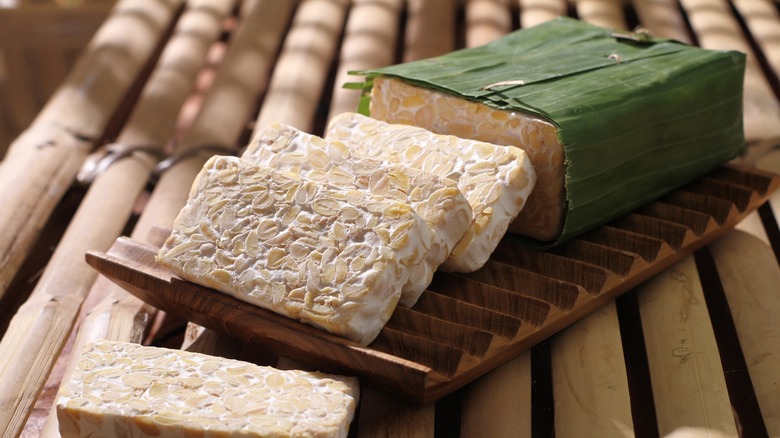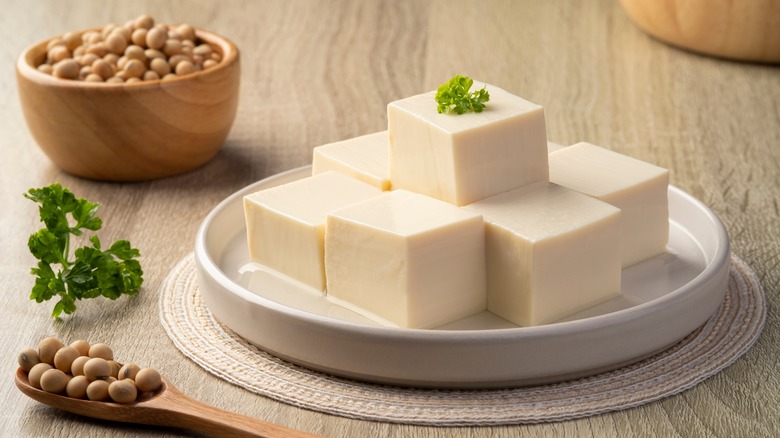What's The Difference Between Tempeh And Tofu?
Soybeans give us many wonderful foods: soy sauce, miso paste, edamame — the list is lengthy. Tofu and tempeh, two popular processed soy foods, might at first glance seem similar, and there are some commonalities, particularly concerning their nutritional and health benefits. According to Healthline, both foods are great sources of plant-based proteins, as well as isoflavones known as phytoestrogens, a plant-based compound that mimics the human hormone, estrogen. Isoflavones are associated with many health benefits, and may reduce the risk of certain cancers and heart disease. Tofu has fewer calories and more calcium than tempeh, but tempeh is higher in protein and fiber.
But there's much that distinguishes tempeh and tofu, which are quite distinct both in origin and culinary application. Tofu and tempeh were created in different places at different times, and are quite different both in texture and taste. Tofu, made from coagulated soy milk, is almost like a block of cheese, soft and incredibly versatile. Tempeh, fermented soybeans pressed into a bar or cake, is more like soy beef: dense and protein-rich.
Tempeh: A fermented meat substitute from Indonesia
Unlike almost every other soy-based food, tempeh originated in Indonesia, likely Java, hundreds of years ago. It's made out of whole fermented soybeans, but often contains other ingredients such as quinoa, brown rice, or chickpeas. Once the soybeans are soaked, cracked, and steamed, they're inoculated with a Rhizopus mold (traditionally by being wrapped in hibiscus leaves, which contain the culture). Mycelium threads then bind the soybeans together. The result is a dense, compact cake covered in white mold. Tempeh is also about 90% protein as well as being high in fiber, which Healthline credits with providing beneficial prebiotics that promote gut bacteria.
Because it's so robust and protein-rich, tempeh is used in a wide variety of recipes, often as a vegan meat substitute in cooking. It can be sliced and fried to be the "bacon" in a BLT; crumbled, seasoned, and cooked like ground beef for tacos or chili; or battered and fried for a remarkably delicious fish-sandwich knockoff. Because of its slightly nutty, neutral flavor, tempeh can take on the profile of whatever dish it's being used in, be it sweet, savory, or spicy.
Tofu: A soft culinary chameleon
According to the history of tofu, it was invented in China probably thousands of years ago, making it considerably older than tempeh. Tofu is also made out of soybeans — or rather soy milk, in a process similar to cheesemaking: A coagulant like salt or acid is introduced to the soy milk, causing the liquid to curdle. There are different kinds of tofu available, sold in various states of firmness: silken, firm, medium-firm, and extra firm. Tofu's neutral flavor is much more delicate than tempeh, without any of tempeh's nuttiness from added ingredients, or mushroomy flavors resulting from fermentation. Tofu is always gluten-free, but some types of tempeh contain barley, so if you have an intolerance, check tempeh ingredient lists and labels.
As a culinary ingredient, tofu is the soul of versatility. You'll see it cubed in miso soup, baked to a delectable firmness in Thai curries, deliciously deep-fried in Japanese aburaage, or even scrambled like eggs. Flavorless tofu takes on whatever flavors are in the dish, and its porousness makes it especially good for absorbing marinades of all types. Because tofu is so absorbent, and is usually packaged in water to keep it moist, the extra liquid needs to be pressed out of the tofu before you cook with it. Once dry, tofu can be fried, stir-fried, baked, sauteed, or even scrambled — it's a blank slate, ready to be filled with colorful flavors.


